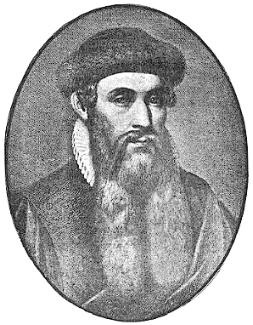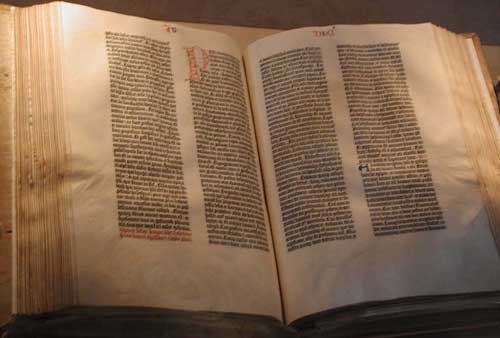|
|
| Home |Software | Web Games | Quizzes | Free for Teachers | About | Contact | Links |
|
|
Gutenberg
Johannes Gensfleisch zur Laden zum Gutenberg (c. 1398 – c. February 3, 1468) was a German metal-worker and inventor who achieved fame for his contributions to the technology of printing during 1448, including a type metal alloy and oil-based inks, a mould for casting type accurately, and a new kind of printing press based on presses used in wine-making. The exact origin of Gutenberg's first presses is apparently unknown, and several authors cite his earliest presses as adaptations of heavier binding presses which were already in use. Tradition credits him with inventing movable type in Europe -- an improvement on the block printing already in use there. By combining these elements into a production system, he allowed for the rapid printing of written materials, and an information explosion in Renaissance Europe.

Gutenberg was born in the German city of Mainz, as the son of a merchant named Friele Gensfleisch zur Laden, who adopted the surname "zum Gutenberg" after the name of the neighborhood where the family had moved. Gutenberg was born from a wealthy patrician family, who dated their lines of lineage back to the thirteenth century. Gutenberg's parents were goldsmiths, and minted coins.
Block printing, whereby individual sheets of paper were pressed into wooden blocks with the text and illustrations carved in, was first recorded in Chinese history, and was in use in East Asia long before Gutenberg. By the 12th and 13th century many Arabic and Chinese libraries contained tens of thousands of printed books. The Koreans and Chinese knew about movable metal types at the time, but arising from the complexity of the Chinese writing system, movable type printing wasn't as widely used as that of Renaissance Europe.
It is not clear whether Gutenberg knew of these existing techniques or invented them independently, though the former is considered unlikely because of the substantial differences in technique. Some also claim the Dutchman Laurens Coster as the first European to invent movable type. Gutenberg certainly introduced efficient methods into book production, leading to a boom in the production of texts in Europe -- in large part, owing to the popularity of the Gutenberg Bibles, the first mass-produced work, starting on February 23, 1455. Even so, Gutenberg was a poor businessman, and made little money from his printing system.
Gutenberg began experimenting with metal typography after he had moved from his native town of Mainz to Strassburg (then in Germany, now Strasbourg, France) around 1430. Knowing that wood-block type involved a great deal of time and expense to reproduce, because it had to be hand carved, Gutenberg concluded that metal type could be reproduced much more quickly once a single mould had been fashioned.
In 1455, Gutenberg demonstrated the power of the printing press by selling copies of a two-volume Bible (Biblia Sacra) for 300 florins each. This was the equivalent of approximately three years' wages for an average clerk, but it was significantly cheaper than a handwritten Bible that could take a single monk 20 years to transcribe.

The Gutenberg Bibles surviving today are sometimes called the oldest surviving books printed with movable type -- although actually, the oldest such surviving book was published in Korea in 1377. However, it is still notable, in that the print technology that produced the Gutenberg Bible marks the beginning of a cultural revolution unlike any that followed the development of print culture in Asia. As of 2003, the Gutenberg Bible census includes 11 complete copies on vellum, 1 copy of the New Testament only on vellum, 48 substantially complete integral copies on paper, with another divided copy on paper, and an illuminated page (the Bagford fragment).
The Bible was not Gutenberg's first printed work, for he produced approximately two dozen editions of Ars Minor, a portion of Aelius Donatus's schoolbook on Latin grammar. The first edition is believed to have been printed between 1451 and 1452.
Johann Fust extended Gutenberg 800 guilders, at the beginning of their partnership in 1436, to allow him to carry out his work. The money Gutenberg earned at the fair was not enough to repay Fust for his investments, which eventually exceeded 2000 guilders. Fust sued, and the court's ruling not only effectively bankrupted Gutenberg, but it awarded control of the type used in his Bible, plus much of the printing equipment, to Fust. So, while Gutenberg ran a print shop until shortly before his death in Mainz in 1468, Fust became the first printer to publish a book with his name on it.
Gutenberg was subsidized by the Archbishop of Mainz until his death. Gutenberg was also known to spend what little money he had on alcohol, so the Archbishop arranged for him to be paid in food and lodging, instead of coin.
Although Gutenberg was financially unsuccessful in his lifetime, his invention spread quickly, and news and books began to travel across Europe much faster than before. It fed the growing Renaissance, and since it greatly facilitated scientific publishing, it was a major catalyst for the later scientific revolution. The ability to produce many copies of a new book, and the appearance of Greek and Latin works in printed form was a major factor in the Reformation. Literacy also increased dramatically as a result. Gutenberg's inventions are sometimes considered the turning point from the Mediaeval Era to the Early Modern Period.